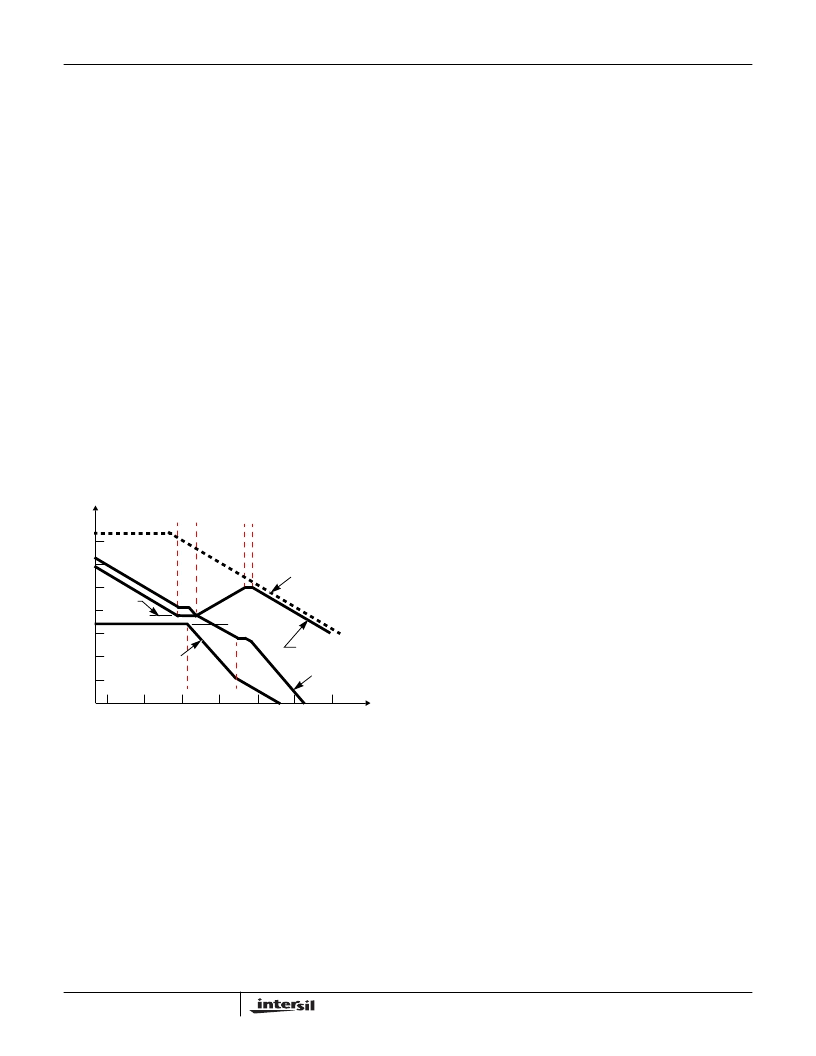- 您現(xiàn)在的位置:買賣IC網(wǎng) > PDF目錄384422 > HIP6005B (Intersil Corporation) Buck Pulse-Width Modulator (PWM) Controller and Output Voltage Monitor PDF資料下載
參數(shù)資料
| 型號: | HIP6005B |
| 廠商: | Intersil Corporation |
| 英文描述: | Buck Pulse-Width Modulator (PWM) Controller and Output Voltage Monitor |
| 中文描述: | 降壓脈寬調(diào)制(PWM)控制器和輸出電壓監(jiān)視器 |
| 文件頁數(shù): | 8/11頁 |
| 文件大小: | 151K |
| 代理商: | HIP6005B |

2-117
Compensation Break Frequency Equations
Figure 8 shows an asymptotic plot of the DC-DC converter’s
gain vs frequency. The actual Modulator Gain has a high gain
peak due to the high Q factor of the output filter and is not
shown in Figure 8. Using the above guidelines should give a
Compensation Gain similar to the curve plotted. The open
loop error amplifier gain bounds the compensation gain.
Check the compensation gain at F
P2
with the capabilities of
the error amplifier. The Closed Loop Gain is constructed on
the log-log graph of Figure 8 by adding the Modulator Gain (in
dB) to the Compensation Gain (in dB). This is equivalent to
multiplying the modulator transfer function to the
compensation transfer function and plotting the gain.
The compensation gain uses external impedance networks
Z
FB
and Z
IN
to provide a stable, high bandwidth (BW) overall
loop. A stable control loop has a gain crossing with
-20dB/decade slope and a phase margin greater than 45
degrees. Include worst case component variations when
determining phase margin.
Component Selection Guidelines
Output Capacitor Selection
An output capacitor is required to filter the output and supply
the load transient current. The filtering requirements are a
function of the switching frequency and the ripple current.
The load transient requirements are a function of the slew
rate (di/dt) and the magnitude of the transient load current.
These requirements are generally met with a mix of
capacitors and careful layout.
Modern microprocessors produce transient load rates above
1A/ns. High frequency capacitors initially supply the transient
and slow the current load rate seen by the bulk capacitors.
The bulk filter capacitor values are generally determined by
the ESR (Effective Series Resistance) and voltage rating
requirements rather than actual capacitance requirements.
High frequency decoupling capacitors should be placed as
close to the power pins of the load as physically possible. Be
careful not to add inductance in the circuit board wiring that
could cancel the usefulness of these low inductance
components. Consult with the manufacturer of the load on
specific decoupling requirements. For example, Intel
recommends that the high frequency decoupling for the
Pentium Pro be composed of at least forty (40) 1
μ
F ceramic
capacitors in the 1206 surface-mount package.
Use only specialized low-ESR capacitors intended for
switching-regulator applications for the bulk capacitors. The
bulk capacitor’s ESR will determine the output ripple voltage
and the initial voltage drop after a high slew-rate transient. An
aluminum electrolytic capacitor's ESR value is related to the
case size with lower ESR available in larger case sizes.
However, the Equivalent Series Inductance (ESL) of these
capacitors increases with case size and can reduce the
usefulness of the capacitor to high slew-rate transient loading.
Unfortunately, ESL is not a specified parameter. Work with
your capacitor supplier and measure the capacitor’s
impedance with frequency to select a suitable component. In
most cases, multiple electrolytic capacitors of small case size
perform better than a single large case capacitor.
Output Inductor Selection
The output inductor is selected to meet the output voltage
ripple requirements and minimize the converter’s response
time to the load transient. The inductor value determines the
converter’s ripple current and the ripple voltage is a function
of the ripple current. The ripple voltage and current are
approximated by the following equations:
Increasing the value of inductance reduces the ripple current
and voltage. However, the large inductance values reduce
the converter’s response time to a load transient.
F
Z2
1
R
3
) x C
3
--------------------------+
=
F
P1
2
π
x R
2
x
2
1
2
----------------------
--------------------------------------------------------
=
F
P2
3
3
------------------------------------
=
F
Z1
2
1
------------------------------------
=
100
80
60
40
20
0
-20
-40
-60
F
P1
F
Z2
10M
1M
100K
10K
1K
100
10
OPEN LOOP
ERROR AMP GAIN
F
Z1
F
P2
F
LC
F
ESR
COMPENSATION
GAIN
G
FREQUENCY (Hz)
20LOG
(V
IN
/
V
OSC
)
MODULATOR
GAIN
FIGURE 8. ASYMPTOTIC BODE PLOT OF CONVERTER GAIN
20LOG
(R
2
/R
1
)
CLOSED LOOP
GAIN
I
V
-------------------------------
x
V
–
S
V
IN
---------------
=
V
OUT
I x ESR
=
HIP6005B
相關(guān)PDF資料 |
PDF描述 |
|---|---|
| HIP6005BCB | Buck Pulse-Width Modulator (PWM) Controller and Output Voltage Monitor |
| HIP6005BCV | Buck Pulse-Width Modulator (PWM) Controller and Output Voltage Monitor |
| HIP6006CBZ | Buck and Synchronous-Rectifier Pulse-Width Modulator (PWM) Controller |
| HIP6006CBZ-T | Buck and Synchronous-Rectifier Pulse-Width Modulator (PWM) Controller |
| HIP6011 | Buck Pulse-Width Modulator (PWM) Controller and Output Voltage Monitor |
相關(guān)代理商/技術(shù)參數(shù) |
參數(shù)描述 |
|---|---|
| HIP6005BCB | 制造商:Rochester Electronics LLC 功能描述:PWM CONTROLLER 3.5 TO 1.3V DAC RANGE,20LD SOIC - Bulk |
| HIP6005BCB WAF | 制造商:Harris Corporation 功能描述: |
| HIP6005BCB-T | 制造商:未知廠家 制造商全稱:未知廠家 功能描述:Voltage-Mode SMPS Controller |
| HIP6005BCV | 制造商:INTERSIL 制造商全稱:Intersil Corporation 功能描述:Buck Pulse-Width Modulator (PWM) Controller and Output Voltage Monitor |
| HIP6005BCV-T | 制造商:未知廠家 制造商全稱:未知廠家 功能描述: |
發(fā)布緊急采購,3分鐘左右您將得到回復(fù)。